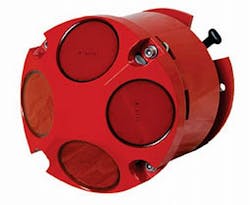Special Operations Command looking for next-gen underwater navigation instruments
MacDILL AFB, Fla., 2 Aug. 2013.Underwater navigation experts at U.S. Special Operations Command (SOCOM) at MacDill Air Force Base, Fla., are reaching out to industry to find companies able to design a next-generation Doppler velocity log (DVL) navigation instrument for manned and unmannedsubmarines.
The underwater navigational instrument should be a drop-in replacement of the Broadband DVL-1553 installed in the current generation of Navy underwater vehicles, SOCOM officials say.
SOCOM this week issued a sources-sought notice (Replacement_Doppler_Velocity_Log) to acquire drop-in replacement Doppler velocity log (DVL) with MIL-STD-1553B-2013 using the latest technology. The DVL shall be integrated with an OCTANS 1000 gyrocompass and a pressure sensor.
SOCOM experts would like a next-generation DVL that retains he output modes, command structure, and communications protocol of the Broadband DVL-1553, as well as maintain the mechanical fit of the current system, minimizing any change to the Navy underwater vehicle.
A Doppler velocity log bounces sound signals off the ocean floor to enable manned and unmanned surface ships and submarines to determine their positions and navigate accurately while submerged or on the surface. They often are coupled with other navigational devices such as inertial measurement gyros and GPS receivers.
DVL designers include Teledyne RDI Instruments in Poway, Calif.; the Kearfott Corp. Guidance & Navigation Division in Little Falls, N.J.; LinkQuest Inc. in San Diego; Marport C-Tech Ltd. in Cornwall, Ontario; Hydro Products Ltd. in Whitehouse, Scotland; SonTek in San Diego; Rowe Technologies Inc. in Poway, Calif.; and Advanced Navigation in Sydney, Australia.
SOCOM officials caution that this is a sources-sought notice, not a formal solicitation, so they are not ready to take industry proposals yet. With that in mind, SOCOM officials are looking for a next-generation DVL with:
-- firmware to interface with third-party sensors;
-- the ability to interface with the MIL-STD-1553 databus with custom commands and data output formats;
-- an RS-232-to-MIL-STD-1553 converter device in the DVL housing;
-- a DC/DC converter power supply for the DVL, the RS-232-to-MIL-STD-1553 converter, the pressure sensor, and the OCTANS gyrocompass; and
-- a housing or adapter kit to enable the DVL to interface to the existing Navy underwater mounting configuration.
This next-generation DVL should be able to maintain bottom lock over an altitude range of 600 to 700 feet, with three-to-four-foot accuracy, with drift of no more than six centimeters per second at 300 feet. Its maximum depth rating should be 3,300 feet.
The devices's transducer should be 6061-T6 aluminum with a hard coat anodize IAW MIL-A-8625F, Type III, class 1 with a sodium dichromate seal.
The DVL should be no longer than 18 to 22 inches, and no wider than eight inches in diameter. It should have an internal temperature sensor, pressure sensor, and should interface with the OCTANS 1000 gyrocompass from iXSea Inc. in Woburn, Mass.
The DVL should operate with a supply voltage of 18 to 37 volts DC, operate in temperatures from -5 to 40 degrees Celsius, and have no internal condensation. The device also should be able to meet industry standards including IEC 60945 and IEC 1010-1.
Companies interested should email SOCOM's Lionel Lawson no later than 14 Aug. 2013 at [email protected]. Include organization name, cage code, duns number, address, email address, web site address, telephone number, size and type of ownership for the organization, and capability statements.
For questions or concerns contact Lawson by email at [email protected], or by phone at 813-826-6957. Also contact Lois Brockson by email at [email protected], or by phone at 813-826-8909.
More information is online at https://www.fbo.gov/spg/ODA/USSOCOM/SOAL-KB/Replacement_Doppler_Velocity_Log/listing.html.

